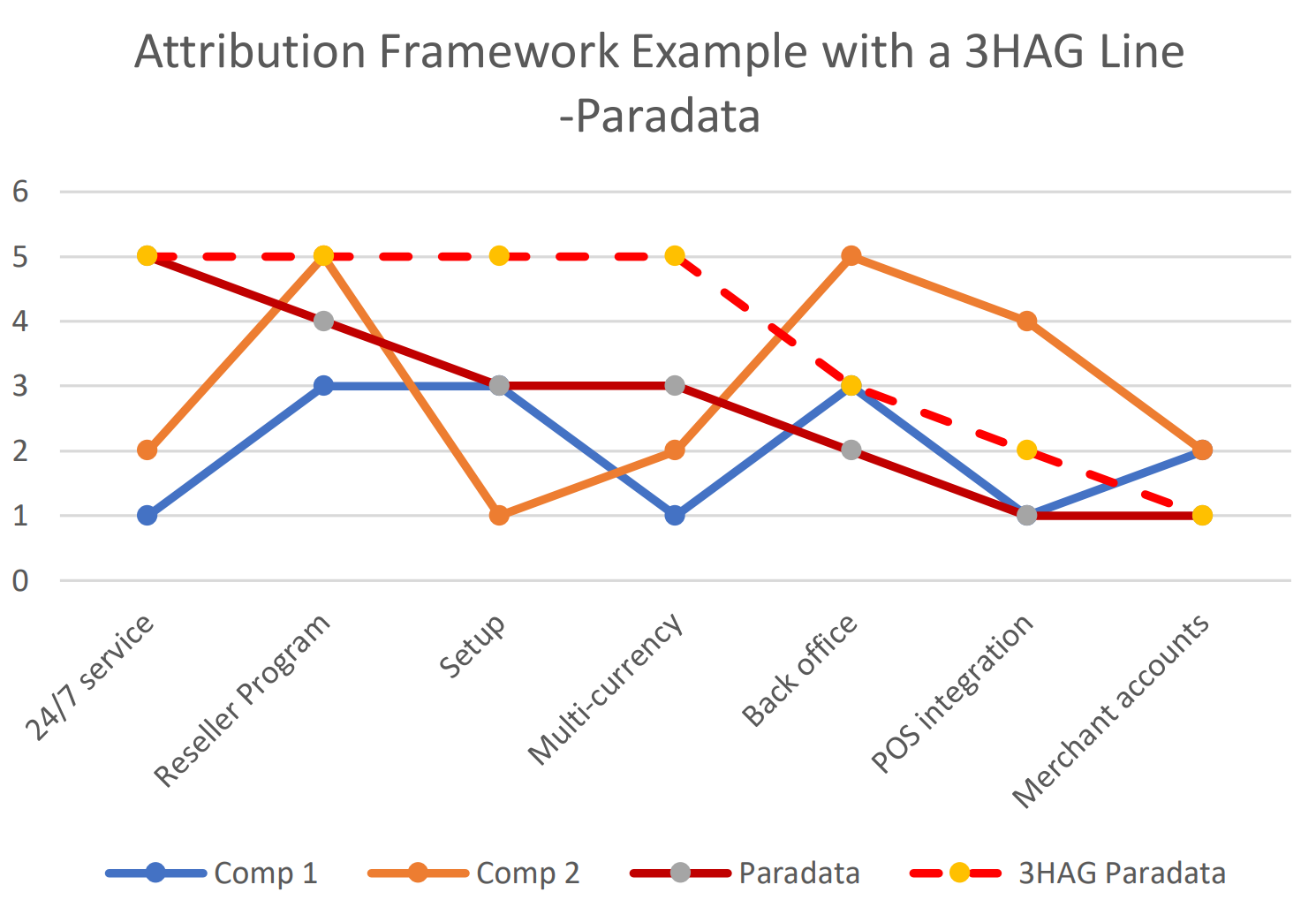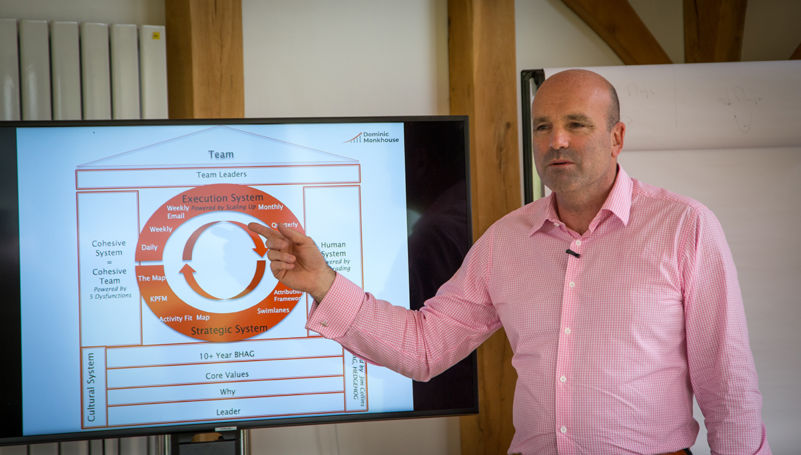Do you have a clear strategy for your business? Such a simple question but boy, can it be difficult to answer. It’s so easy to get bogged down in vague ideas and meaningless corporate jargon. An attribution map will help you get clarity.
Often, when new clients talk me through their strategy, I can tell it’s based on guesswork. There’s little research to back it up. I ask them, ‘Why are you different? Why do customers buy from you?’ Deathly silence. After a pause, they give me an uncertain answer. I ask, ‘Is that also true of your competitors?’ Nine times out of ten, the answer’s ‘Yes’. Knowing your unique difference is the key to future growth. Without this, you’ll end up competing on price. It’s the only lever you’ve got to pull.
There are many definitions of strategy. My personal favourite is Michael Porter’s. Writing for the Harvard Business Review, he says that strategy is the ‘creation of a unique and viable position involving a different set of activities’. The keywords here are ‘unique’ and ‘different’. So rather than trying to be the biggest or the best, your strategy should focus on the difference you offer the market.
All well and good. You’ve probably heard this many, many times before. But the challenge comes when you try and work it out. It’s not easy. And then you need a plan to deliver on it. Even harder! I’ve worked with many strategic tools through my career as MD of fast-growing tech companies and, more recently, as a business coach. My recommendation? Attribution mapping. Hands down. It’s just fab!
What is attribution mapping?
I first came across this during a training programme for certification in 3HAG (short for 3-year Highly Achievable Goal) created by Shannon Susko. Having grown and sold two SaaS companies in Canada, Shannon was well versed in Verne Harnish’s ‘Scaling-Up’ methodologies. However, she identified areas that she felt could be even slicker, particularly around the connection of strategy and execution. The 3HAG Way is the strategic execution system that ensures your strategy is NOT a Wild-Ass-Guess!
6 key elements of 3HAG Way to bridge your strategy from 90 days to BHAG
The Map – The internal and external relationship map
Core Customer – Who is your “who”?
Attribution Map – What does your core customer expect from you?
Differentiating actions – 3-5 things that create your unique and valuable position
Swimlanes – Do you know where you are going and when?
36-month rolling “forecast” (not budget) – Keep rolling it forward
Attribution Map
One of the main tools of 3HAG is attribution mapping. It’s beautifully simple, providing a comprehensive picture of your competitive position in the market, along with a practical road map for the next three years. It can differentiate you by identifying the activities you need to focus on which, combined, will make you stand out. The aim is to get to a place where your company is not in competition with any other. You’re not pitching against anyone else. There’s your proposal and only your proposal. That way you won’t come under price pressure and customers will buy at a profit.
How does it work?

Before you begin, you’ll need a good understanding of your core customer. So, in fifty words or less, can you describe your main customer, the problem that they have and the solution that you offer to solve that problem? You’ll also need to understand your competition – and I mean, really understand them. How they go to market, their pricing and how their products differ to yours. It amazes me how many business leaders I speak to who don’t have a real handle on this. They’re all very busy, doing stuff. But it’s not strategic stuff that will take them in the right direction. It’s like they’re re-arranging deckchairs on the Titanic!
Start by getting into the shoes of your core customer. Brainstorm all the attributes you’d look for to help you make a buying decision. Think again about their problem and what they need in a solution. There are no bad answers here. Get them all up on the board. Next stage is to agree the top 10 to 15. Some may be technically correct but aren’t really important. To hone them down, you may need to keep coming back to your core customer – some attributes may be important to them but not to another. Remember you’re not trying to sell everything to everyone. You’re trying to solve a problem for a small cohort of customers.
Once you’ve got your list of attributes, you score your company out of five on each of them. Be honest – you can’t be brilliant at everything! Rank them in order then go through the same exercise with your three main competitors.
Finally, load this data into the Attribution Framework chart and you can see where your company is relative to the competition. And you can start to work out where you want to be in three years.
Why is attribution mapping so useful?
There are a number of crucial reasons why I think this is the best strategic execution tool out there:
1) Tells you where to focus.
Attribution mapping shines a light on why customers buy and whether you’re any good at these things when everything’s unbundled. Only one attribute can be about price. There are 14 others that aren’t. Working out a) what they are b) how you’re doing at them relative to others and c) whether you’re as good as you need to be is invaluable. Then you can make a plan to get better in targeted areas.
This process will tell you what to say ‘no’ to in future. When I was MD at Rackspace, we knew exactly which niche we wanted to focus on. Selling hosting to customers with Linux or, later, Microsoft platforms who had a big budget and really cared about service. We said ‘no’ to a whole load of other things – telephony, connectivity, professional services – our default response was ‘no’. We said we were an inch wide and a mile deep.
Just going through the attribution mapping process will show you where there are gaps in your executive team’s knowledge. I did this recently with a client and it was soon clear they were guessing about the competition. So, they decided to hire a 3rd party firm to shop from their five largest competitors. Their brief was to evaluate customer experience pre-sale. This exercise gave them valuable data on the questions customers were asked and how their competitors sized and scoped their solutions. I love a bit of mystery shopping! Armed with copies of their competitors’ proposals, they finally had an accurate idea about their own pricing.
If you don’t have this information, how do you know if you’re undercharging? Yes – it’s important that you’re not the most expensive in your market but you can be as expensive as your most expensive competitor. If undercharging really is your strategy, you should be achieving significantly increased volume relative to your competitors and your proposition. In most of the examples I see, there’s no price elasticity. So, putting prices up doesn’t reduce demand and bringing them down doesn’t increase it. Your salespeople might blame price for their failure to sell but it’s more often about them and their ability (or lack of it!)
2) Identifies opportunity gaps in your market
One of the major light-bulb moments of attribution mapping is when, after finishing your map, areas of white space appear on the graph that neither you nor your competitors are occupying. You’ve found your potential niche! The look on everyone’s faces as they start to see how the future could look is just excellent. Now they know which attributes they need to focus on to push their product into this space.
Adding your ‘3HAG’ line completes this picture – below is an illustration showing the map of Paradata, one of Shannon’s companies. You can clearly see the white space in the centre of the graph, occupied by none of the companies. The dotted line shows the attributes they needed to focus on over the following 36 months to truly differentiate themselves from the competition.

3) Provides a road-map for your future activity
This really is your link between strategy and execution. Once you’ve produced your attribution map, you take its output and flip it into swim-lanes. Over the next 3 years, you can now recognise areas where you need to maintain parity with competitors and others where you need to improve. Working as a team, you go on to identify three to five milestones for each important attribute spanning the next 36 months and put them into your plan. You can also de-emphasise less important areas, re-distributing your effort and resources.
My view is that you have to go through attribution mapping before you go to market. If your business is already established, you may need to slow down before you speed up. But the wonderful thing is you’ll know with some certainty that your competitors will not be as focused as you. This is how your company is going to win.
4) Aligns your executive team

I’ve seen with my own eyes how effective this is at galvanising executive teams. It’s such a simple, easy to understand tool. It’s not a 40-page report full of strategic gobbledygook. At the end of the process, your entire team will be aligned on what’s important and what’s not. They will have real clarity on where you are and where you’re heading from a product, service and customer experience perspective.
You may come up against vested interests and fiefdoms. Some might feel under attack from the change that’s needed. It’s a real test of whether your leadership team can have conflict and work through it. Be prepared for comments like, ‘That’s not valid, that isn’t real, that isn’t true.’ Stay strong and make sure the team isn’t paralysed by indecision.
My view is it doesn’t matter if attribution mapping is done badly the first time around. It’s most important to just get going. See where you are. Take an agile approach. So you want to build a castle, and in two weeks, you’ve built a shed? Well – it’s a dwelling. A small step in the right direction. It may not be quite what you want but at least you’re on the way. You’re trying to build a business that’s nimble and lean, travels fast and iterates. Ditch your perfectionist streak. Let’s just get going and see where we get to. And make a plan for the next stage of the journey.
Attribution mapping has been so useful to me. When I’m discussing with clients how I can support them, it gives me complete confidence that I have a simple tool that works. Before using it, they have a busy business intent on getting everyone on the bus and driving around the block every day, getting nowhere. Afterwards, they finally have a clear direction and a route to follow. This is undoubtedly the way to unstick your business.
Written by business growth coach Dominic Monkhouse. Find out more about his work here.
Resources:
My interview with Shannon Susko on Curious Leadership
The Metronome Effect, The Journey to Predictable Profit – Shannon Susko

